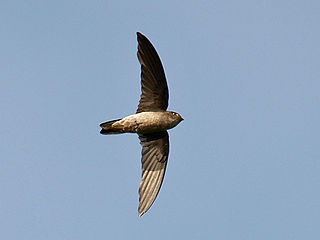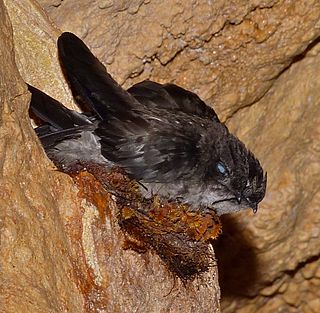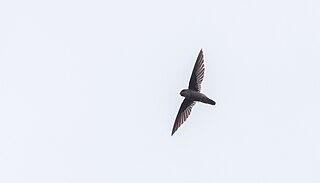
Swiftlets are birds from the four genera Aerodramus, Collocalia, Hydrochous and Schoutedenapus, which form the tribe Collocaliini within the swift family Apodidae. The group contains around thirty species mostly confined to southern Asia, south Pacific islands, and northeastern Australia, all within the tropical and subtropical regions. They are in many respects typical members of the Apodidae, having narrow wings for fast flight, with a wide gape and small reduced beak surrounded by bristles for catching insects in flight. What distinguishes many but not all species from other swifts and indeed almost all other birds is their ability to use a simple but effective form of echolocation to navigate in total darkness through the chasms and shafts of the caves where they roost at night and breed.

Aerodramus is a genus of small, dark, cave-nesting birds in the Collocaliini tribe of the swift family. Its members are confined to tropical and subtropical regions in southern Asia, Oceania and northeastern Australia. Many of its members were formerly classified in Collocalia, but were first placed in a separate genus by American ornithologist Harry Church Oberholser in 1906.

The mossy-nest swiftlet is a species of swift in the family Apodidae. Some taxonomists consider it to be a subspecies of the uniform swiftlet. It is found in northern Borneo, the Natuna and the Derawan Islands and Nias island off western Sumatra. Its natural habitat is subtropical or tropical moist lowland forests.

The edible-nest swiftlet, also known as the white-nest swiftlet, is a small bird of the swift family which is found in Southeast Asia. Its opaque and whitish bird nest is made exclusively of solidified saliva and is the main ingredient of bird's nest soup, a delicacy of Chinese cuisine. Germain's swiftlet is now treated as conspecific with this species.
The Mariana swiftlet or Guam swiftlet is a species of swiftlet in the family Apodidae.

The Mascarene swiftlet or Mauritius swiftlet is a species of swift in the family Apodidae. It is found in Mauritius and Réunion, and the populations on the two islands have recently been confirmed to differ subspecifically. The nominate race francicus is found on Mauritius and the recently described race saffordi occurs on Réunion. Its natural habitats are subtropical or tropical moist lowland forest, subtropical or tropical high-altitude shrubland, subtropical or tropical high-altitude grassland, caves, arable land, and heavily degraded former forest. It is threatened by habitat loss.
The mountain swiftlet is a species of swift in the family Apodidae. It is endemic to the island of New Guinea and the nearby islands of Karkar, Yapen and Goodenough. It was once placed in the genus Collocalia but has been moved, with many others, to Aerodramus. The species is divided into three subspecies, with the nominate, A. h. hirundinacea ranging over most of New Guinea, the subspecies A. h. excelsus occurring over 1600 m in the Snow Mountains and Cartenz peaks of Irian Jaya and A. h. baru being restricted to Yapen Island. It occurs in alpine areas from 500 m to the treeline. Its natural habitat is tropical moist montane forests and other mountainous habitats in New Guinea. It also occurs in lower numbers in the lowlands near hills.
The Moluccan swiftlet is a small bird in the swift family Apodidae that is found on Sulawesi and on the Maluku Islands in Indonesia. Two subspecies, the Sulawesi swiftlet and the Seram swiftlet, have sometimes been considered as separate species.
The Tahiti swiftlet or Polynesian swiftlet is a species of swift in the family Apodidae. While often compared to the Marquesan Swiftlet, this bird is often more pale faced. The subspecies is the Monotypic which means it does not include a subspecies.

The black-nest swiftlet is a species of swift in the family Apodidae. It is found in Brunei, Indonesia, Malaysia, Myanmar, the Philippines, Singapore, Thailand, and Vietnam. Its natural habitats are subtropical or tropical moist lowland forest and subtropical or tropical moist montane forest.

The Philippine swiftlet is a species of swift in the family Apodidae. It is endemic to the Philippines.
The bare-legged swiftlet is a species of swift in the family Apodidae. It is found in New Guinea, in subtropical and tropical moist montane forests.
Mayr's swiftlet is a species of swift in the family Apodidae. It is found in New Ireland and Guadalcanal.

The Palau swiftlet is a species of swift in the family Apodidae. It is endemic to Palau.

The Atiu swiftlet or Sawtell's Swiftlet is a species of bird in the swift family, endemic to Atiu in the Cook Islands.

The white-rumped swiftlet is a species of swift in the family Apodidae.

Whitehead's swiftlet is a species of swift in the family Apodidae. It is endemic to the Philippines. It is named after the British explorer John Whitehead (1860–1899). Its natural habitat is subtropical or tropical moist montane forests. Its status is insufficiently known.

The Australian swiftlet is a small bird belonging to the genus Aerodramus in the swift family, Apodidae. It is endemic to Queensland in north-eastern Australia. It was formerly included in the white-rumped swiftlet but is now commonly treated as a separate species. It has two subspecies which are occasionally regarded as two separate species: A. t. terraereginae and A. t. chillagoensis.
The Mangaia swiftlet is an extinct species of bird in the swift family. It became extinct during prehistoric times. It was endemic to Mangaia in the Cook Islands. It was closely allied with the extant Atiu swiftlet of Atiu, Mangaia's neighbouring island, though it was probably slightly larger.
The volcano swiftlet is a species of bird in the Apodidae family, formerly considered conspecific with the Himalayan swiftlet .The Volcano swiftlet is commonly measured at 13 to 14 cm long and characterized as dark gray with an unmissable brown rump band, whereas younger individuals show a less defined band. They can be easily heard because of the unique "Teeree teereeeee teeereeeee" clicking sound they make. Nothing is known about the diet of this bird. Many species of Aerodramus swiftlets nest colonially in caves, which leads them to use echolocation to navigate through the dark environments like caves and crevices, as well as during the twilight hours. While the swiftlet can echolocate like the very known species of the bat, they are much less educated and less refined in using it for capturing prey. This echolocation capability distinguishes Aerodramus from closely related genera like hydrochous and most species within Collocalia.












